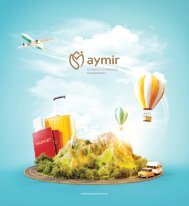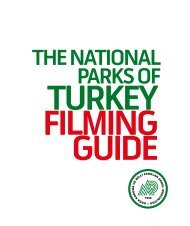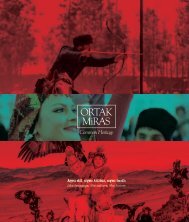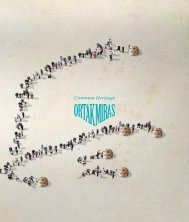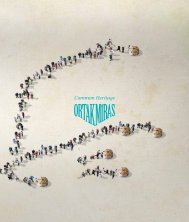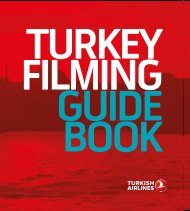Create successful ePaper yourself
Turn your PDF publications into a flip-book with our unique Google optimized e-Paper software.
leşik hayatın yoğunlukta olduğu kültür ortamlarında da<br />
büyük ölçüde süreklilik göstermiştir. “Türk bozkır kültürü”<br />
(Kafesoğlu 1987) olarak adlandırılan bu özgün yaşam<br />
biçimi, “animistik dünya görüşü” ve animistik inançlar<br />
çerçevesinde şekillenmiş; bu durum, toplumun doğadaki<br />
tüm unsurlarla ahenkli bir varoluşunu gerekli kılmıştır.<br />
Bu varoluş sistemi, toplumun gökyüzü, yeryüzü, yeraltı<br />
ve buralardaki tüm varlıklara dair tasavvurunu son derece<br />
etkin biçimde çeşitlendirmiş ve bitkiler, dağlar, ağaçlar,<br />
taşlar, kayalar, sular, ateş, hava, toprak, madenler, hayvanlar<br />
yaşanılan çevrenin canı ve ruhu olan aktif unsurları<br />
olarak kabul edilmiştir. Bunlar arasında hayvan unsuru<br />
toplumun, beslenme, barınma, giyinme, avlanma gibi hayati<br />
ihtiyaçlarını karşılamada en vazgeçilmezi olması bakımından<br />
yaşamın her alanında önem ve değer taşımıştır.<br />
Öyle ki yaşam alanının bu vazgeçilemez unsuru, hayati<br />
ihtiyaçları karşılama vasıtası olmanın yanı sıra, günlük ihtiyaçlara<br />
birer yanıt olarak keşfedilen bütün maddi kültür<br />
ürünlerinin süslenmesinde ve bezenmesinde kendine yer<br />
bulmuş Türklerin geleneksel dünya görüşünü yansıtan her<br />
bir sanat varlığında yer alarak “hayvan üslûbu” şeklinde<br />
ifade edilen bir sanat üslûbunun ortaya çıkmasının nedeni<br />
olmuştur. Böylece, “Bozkırların yüzyıllarca efendisi olan<br />
Türk boyları” (Çay1983: 10), anlayış, algılayış ve davranış<br />
örüntülerini gerçekleştirmede değer verdikleri hayvanları<br />
anlamlı birer sembol haline getirerek hayvan üslûbu<br />
etrafında edebiyatı, güzel sanatları, inançları kapsayan oldukça<br />
işlevsel bir faaliyetler sistemi kurmuştur. Ön Asya<br />
ve Doğu Akdeniz başta olmak üzere başka birçok sanatsal<br />
oluşumda hayvan motiflerinin yoğun olarak görülmesine<br />
rağmen, Türklerin hayvan üslûbuna dayalı sanat anlayışına<br />
getirdiği zevkin inkâr edilemeyeceğine (Roux 2001: 292)<br />
dair kabul, Türklerin, edebiyat, inanç, süs eşyası, petroglif,<br />
halı, kilim, at koşum takımları gibi birçok alanda hayvan<br />
motiflerini sembolleştirerek ve stilize ederek, bu üslûbu<br />
özgün ve üstün kıldıklarını göstermektedir.<br />
Türk milleti, hâkimiyet kurduğu coğrafyalarda, kendinden<br />
önce var olan sanat birikimi ile bütünleşmiş, kendi<br />
dünya görüşüne yönelik birikimi ile özgün ve renkli üslûbunu<br />
yaratarak, Türk dünyası kültür anlayışını en canlı<br />
ve zengin şekilde ifade eden mimari, taş süslemeciliği,<br />
seramik, çini, halı ve kilim, kumaş dokumacılığı, ahşap<br />
süslemeciliği, maden süslemeciliği, kitap sanatları, cam<br />
süslemeciliği gibi birçok sanat dalında eşsiz eserler ortaya<br />
koymuştur. Bu eserler, bozkır kültürü dönemde, göçer<br />
evli yaşamın ve animistik inanç sisteminin sonucu olarak<br />
doğada var olan taş, kaya gibi unsurların üzerine işlenmiş<br />
ve resmedilmiş olarak, yerleşik düzene geçildikten sonraki<br />
dönemde insanların farklı ihtiyaçlarına çözüm olarak hayata<br />
geçirilmiş abidevi yapılar, camiler, hanlar, medreseler,<br />
evler, köprüler veya halılar, sehpalar, kitaplar, bardaklar,<br />
world view” and animistic beliefs; this situation has necessitated a<br />
harmonious existence of society with all the elements in the nature.<br />
This system of existence has diversified the concept of the society<br />
about the sky, the earth, the underground and all the beings in<br />
this area in an extremely effective way and this is accepted as active<br />
elements including plants, mountains, trees, rocks, water, fire, air,<br />
earth, mines, animals.Among them, the animal factor society carries<br />
importance and value in every aspect of life in terms of being<br />
the most indispensable to meet the vital needs such as nutrition,<br />
sheltering, dressing and hunting. Such an indispensable factor of<br />
the living space is not only a means of meeting life necessities but<br />
also a form of “animal style” taking place in every artistic entity<br />
reflecting the traditional world view of Turks, who have found animal<br />
style and used it in the embellishment and decoration of all the<br />
cultural products as a response to daily necessities.Thus, “the Turkish<br />
tribe master of the steppesthroughout the centuries” (Çay1983:<br />
10) has established a highly functional system of activities around<br />
the animal style including literature, fine arts and beliefs by making<br />
the animals that they value a symbol in order to carry out the<br />
understanding, perception and behavior patterns. Although animal<br />
motifs are seen in many other artistic formations, especially in<br />
Asia Minor and Eastern Mediterranean Sea;the acceptance, which<br />
is about that the Turks bring about the pleasure for understanding<br />
of art based on the animal style (Roux 2001: 292), shows that they<br />
make them unique and superior bysymbolizing and stylingthe animal<br />
motifs in many areas such as the literary, belief, ornament,<br />
petroglyph, carpets, rugs, horse harnesses.<br />
The Turkish nation becomes integrated with the works of art made<br />
before they came in its dominant geographies and has revealed<br />
many unique pieces in many art branches such as architecture,<br />
stone ornamentation, ceramics, tiles, carpets and cloths weaving,wood<br />
ornamentation, ornamentation of mines, book arts,<br />
glass ornaments expressing the Turkish world culture in the most<br />
vibrant and rich way by creating a unique and colorful style integrated<br />
with its own world view.These artifacts are depicted and<br />
painted on stone, rock, etc. as a result of nomadic life and animistic<br />
belief system in the steppe culture period. In the period after the<br />
permanent settlement; monumental structures, mosques, inns,<br />
madrasahs, houses, bridges or carpets, tables, books, glasses, ornaments<br />
have been spreadin all settlement areas in the territory of the<br />
Turkish worldfor centuries and have left their marks as numerous<br />
goods and means that both gain favor and carry artistic features.<br />
In the”Ordu-Balıq” system of the approach of urbanization dated<br />
back to pre-islam (Esin 2003: 25-32), continued after Islam<br />
and became the main element of Turkish city settlements as well as<br />
mosque, madrasah and caravanserai architecture. The architecture<br />
of the mosque was also the main execution place of the above-mentioned<br />
arts. The information on pre-Islamic Turkish artifacts has<br />
been obtained from petroglyphs and obelisks, the most famous<br />
of which are the Pazyryk burials, from the excavations of Hun’s<br />
Common Heritage Fine Arts in Turkish People<br />
505<br />
Türkler’de Güzel Sanatlar








